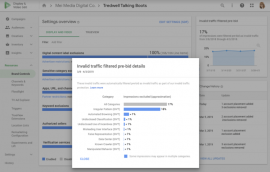Google Display & Video 360 to default to ads.txt inventory, support app-ads.txt


Google announced several brand safety-focused initiatives Tuesday for advertisers using its Display & Video 360 (DV360) DSP. They include defaulting to ads.txt inventory, supporting app-ads.txt and providing a central hub for brand controls in the interface.
Ads.txt default. Starting in August, campaigns will default to ads.txt-authorized inventory only. In turn, that means only publishers that have adopted the standard and have placed ads.txt files on their sites will be eligible for bids from DV360.
Ads.txt launched in 2017 by IAB Tech Lab to reduce programmatic ad fraud by listing authorized ad sellers in a file placed on publishers’ sites. DSPs can crawl the public listing of authorized sellers to screen out unauthorized impressions.
More than 90% of publishers have adopted ads.txt.
App-ads.txt support. Google will also support the newer app-ads.txt standard, which is designed to add inventory transparency for apps on mobile devices as well as connected TVs. It became available in March. In the coming months, Google says DV360 will stop buying unauthorized app inventory. When adoption increases, it too will become the default for campaigns.
“While it’s very early days for app-ads.txt adoption, we’re actively working to encourage app developers to publish app-ads.txt files,” said a Google spokesperson. “In the next few months, Display & Video 360 will stop buying unauthorized app inventory as identified by app-ads.txt files. When adoption of app-ads.txt reaches sufficient levels, we will allow marketers and agencies to choose to buy only app inventory that is authorized.”
Brand Controls dashboard. The new Brand Controls resource in DV360 centralizes the various brand safety controls available in the platform and provides a view of the settings applied to each campaign. That includes a view of exclusions, use of ads.txt-only authorized sellers and verification services for display, video, app and TrueView campaigns.
An invalid traffic report in the new Brand Controls view in DV360. Image: Google
You can make bulk edits with Structured Data Files to brand control settings from the dashboard. And invalid traffic reports show the percentage of pre-bid traffic filtered out and why.
Why we should care. These brand safety initiatives are part of ongoing, and industry-wide efforts to clean up the digital advertising ecosystem and help ensure advertisers that the inventory they’re buying is real and adheres to their brand standards. (Of course, advertisers have repeatedly protested the brand safety of Google’s own YouTube inventory.) Google gave advertisers the option to exclude inventory from publishers without ads.txt files last July. Given its market influence, Google’s support for app-ads.txt will likely speed adoption by app publishers.
The post Google Display & Video 360 to default to ads.txt inventory, support app-ads.txt appeared first on Marketing Land.
From our sponsors: Google Display & Video 360 to default to ads.txt inventory, support app-ads.txt



